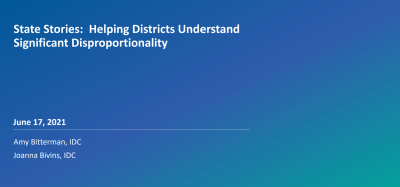States and districts have come a long way in their understanding and implementation of the significant disproportionality regulations—but they know there’s a lot more to do! With this work still in its infancy, and more and more states identifying districts for significant disproportionality for the first time each year, states want to know how best to help their districts navigate the sometimes rocky waters of significant disproportionality.
During the June 2021 IDC webinar, State Stories: Helping Districts Understand Significant Disproportionality, a panel of four state education agency presenters, Seth Bishop with Wisconsin, Alisa Fewkes with Idaho, Laura Jurgensen with Kansas, and Scott Norton with Illinois, plus many others in attendance, shared their strategies for helping districts understand and use data related to significant disproportionality. States also described supports they provide to districts both before and after identification of significant disproportionality. Here are a few key takeaways:
- Present the requirements to districts in ways that are clear and easy to understand. Several states have developed videos and modules that break down the requirements associated with significant disproportionality into smaller accessible chunks. For example, Idaho developed modules that cover topics such as data, timelines, tools, and resources and include lessons and short embedded videos.
- Be proactive! Get data to the districts as early as possible. Giving districts time to review and understand their data and start planning for CCEIS is critical. Several states have “early warning” systems in place to alert districts if they are approaching being identified. For example, within its dashboard of significant disproportionality data for each district, Kansas flags districts that have met the significant disproportionality criteria for two years and, thus, are at-risk of meeting the criteria for a third year and being identified with significant disproportionality. One state even asks districts to develop their CCEIS plans if they meet the criteria for two years, in case they meet the criteria for the third year and are identified.
- Carefully consider what data to share with districts and how to share the data. Many states are developing district-level reports and data dashboards. Striking a balance between providing too much data and overwhelming the districts and ensuring transparency can be a trick. For some examples, see Illinois’s new system and reports Wisconsin developed.
- Invite general education into the conversation. Significant disproportionality is not just a special education issue. States described how they bring general education and special education to the table for districts identified with significant disproportionality. Wisconsin created a joint federal notification process between ESSA and IDEA. Districts identified with significant disproportionality and/or under ESSA are expected to submit a single improvement plan across any IDEA and ESSA determinations, which has helped break down silos between general education and special education.
Remember communication is key! Keep districts and other stakeholders informed of the process in your state for identifying districts for significant disproportionality and the implications of being identified. If you are interested in learning more about states’ strategies for helping districts understand and use data related to significant disproportionality, check out the webinar recording, take a look at the significant disproportionality resources available on the IDC website, or reach out to your IDC State Liaison
- Amy Bitterman and Joanna Bivens
Related Content
Event: Webinar
State Stories: Helping Districts Understand Significant DisproportionalityDo you wonder how other states make districts aware of and help them understand their data related to significant disproportionality? How do states help districts understand their responsibilities when the state has identified them with significant...


